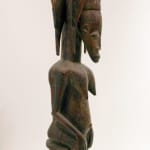Senufo Wooden Sculpture of a Woman, 20th Century CE
Wood
CK.0116
The Senufo are one of West Africa’s most important groups, and also one of the most productive in terms of artistic output. There are roughly 1.5 million Senufo people, living...
The Senufo are one of West Africa’s most important groups, and also one of the most productive in terms of artistic output. There are roughly 1.5 million Senufo people, living across the Ivory Coast, Mali and Burkina Faso. Senufo society is governed by a council of elders and the Poro society. Both of these institutions are beholden to the complex Senufo religious belief system, which – in short – holds that the earth was created by Koulotiolo, that Katieleo regenerates the world through Poro rituals, and that ancestors and bush spirits (mandeo, ndeo or tugu, depending on the language) are all around, and must be appeased. The Senufo are perhaps best known for their artworks, which reflect their complex social structures and belief system. Secular objects such as beds, stools, chairs, heddle pulleys and canes are all decorated with Senufo iconographs, while metal pieces are used as amulets, and for apotropaic functions. The Poro society commissions many masks for ceremonies including dances (kpeliyee masks), initiations (stylised buffalo masks with antelope horns) and funerals/crises (the “firespitter” Janiform buffalo helmet masks). Very rare horse masks are danced at ceremonies for top-ranking poro members. Other non-Poro forms are worn by healers and highly productive farmers. Sculptures are also known, ranging from miniatures up to life-size anthropomorphic pieces. The most famous variant is the pombilele, elongated figures with solid bases which have become known as rhythm pounders. When not being used to keep the rhythm for dancing, they were stood in the Poro society’s sacred enclosures; their other task was to tamp down the earth atop the graves of prominent Poro members, to ensure that the spirit of the dead is directed to the afterlife rather than returning to haunt the living. When in pairs, they represent the primordial couple, an ideal family that respects its ancestors. Very large sculptures of kasingele (first ancestors) were sometimes commissioned by owners of yasungo – shrines on which offerings are made – and also as foci for dancing. Kasingele sometimes appeared in different form, namely as large geometric bird figures (sejen, or fijen) that are carried by initiates and which symbolise the authority of the Poro elders (katyleeo) over their juniors (poro piibele). Finally, special pieces are carved for members of the sandogo divination society, which has its own paraphernalia to ensure the spiritual welfare of their clientele.



